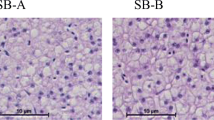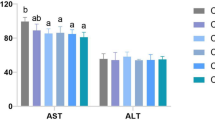Abstract
To investigate the effects of glycerol tributyrin (TB) (Triacylglycerol tributanoate) on the regulation of liver lipid metabolism by intestinal flora of grass carp (Ctenopharyngodon idellus). The compound feed with soybean oil 2.8% + fish oil 1.8%, soybean oil 6.3% + fish oil 1.8%, and soybean oil 6.2% + fish oil 1.8% + TB 0.1% was added to the basal diet as a fat source and fed to the basal (control) group, high lipid (HL) group, and tributyrin (TB) group for 12 weeks. We tested the growth performance, fat content, diversity, and abundance of gut flora and other related indexes of grass carp by Soxhlet extraction, liver tissue enzyme activity, oil red O staining, and 16S rRNA high-throughput sequencing. The results showed that the liver fat number and liver fat content of grass carp in the TB group were lower than those in the HL group, while the fattening degree was significantly higher than those in the other two groups; according to the indices such as Shannon, Ace, and Coverage, it was found that the grass carp in the TB group had the highest abundance and diversity of intestinal microflora; at the portal level, Proteobacteria and Fusobacteria were the main dominant flora in the TB group, with the number of unique OUTs accounting for about 59. 9% of the total number measured; at the genus level, the relative abundance of lipase-producing, short-chain fatty acid-associated bacteria, such as Bacillus-Lactobacillus and Bifidobacterium, was significantly lower (p < 0.05). Thus, we conclude that the addition of TB to high-fat diets can alter the structure of the intestinal microbial community and promote hepatic lipid metabolism in grass carp. TB can alleviate fatty liver in grass carp by increasing the relative abundance of short-chain fatty acids in the intestine. Meanwhile, TB inhibits the conversion of primary bile acids to secondary bile acids in the host, which can block intestinal FXR signaling and the hepatic FXR-SHP pathway, thus slowing down fat synthesis and alleviating the accumulation of liver lipids in grass carp.






Similar content being viewed by others
Data availability
The data presented in this study is contained within the article and supplementary material.
References
Cao W, Zheng C, Xu X, Jin R, Huang F, Shi M, He Z, Luo Y, Liu L, Liu Z, Wei J, Deng X, Chen T (2022) Clostridium butyricum potentially improves inflammation and immunity through alteration of the microbiota and metabolism of gastric cancer patients after gastrectomy. Front Immunol 13:1076245. https://doi.org/10.3389/fimmu.2022.1076245
Chen G, Ran X, Li B, Li Y, He D, Huang B, Fu S, Liu J, Wang W (2018) Sodium butyrate inhibits inflammation and maintains epithelium barrier integrity in a TNBS-induced inflammatory bowel disease mice model. EBioMedicine 30:317–325. https://doi.org/10.1016/j.ebiom.2018.03.030
Da Silva CC, Monteil MA, Davis EM (2020) Overweight and obesity in children are associated with an abundance of firmicutes and reduction of bifidobacterium in their gastrointestinal microbiota. Child Obes 16(3):204–210. https://doi.org/10.1089/chi.2019.0280
Ding L, Yongqing M, Fasheng C (1990) Nutritional lipid liver disease of grass carp Ctenopharyngodon idullus (C et V). Chin J Oceanol Limnol 8(4):363–373. https://doi.org/10.1007/BF02849682
Ding Q, Zhang Z, Ran C, He S, Yang Y, Du Z, Zhang J, Zhou Z (2018) The hepatotoxicity of palmitic acid in zebrafish involves the intestinal microbiota. J Nutr 148(8):1217–1228. https://doi.org/10.1093/jn/nxy084
Dong L, Zhong X, He J, Zhang L, Bai K, Xu W, Wang T, Huang X (2016) Supplementation of tributyrin improves the growth and intestinal digestive and barrier functions in intrauterine growth-restricted piglets. Clin Nutr 35(2):399–407. https://doi.org/10.1016/j.clnu.2015.03.002
Feng W, Wu Y, Chen G, Fu S, Li B, Huang B, Wang D, Wang W, Liu J (2018) Sodium butyrate attenuates diarrhea in weaned piglets and promotes tight junction protein expression in colon in a GPR109A-dependent manner. Cell Physiol Biochem 47(4):1617–1629. https://doi.org/10.1159/000490981
Grigor'eva IN (2020) Gallstone disease, obesity and the firmicutes/bacteroidetes ratio as a possible biomarker of gut dysbiosis. J Pers Med 11(1). https://doi.org/10.3390/jpm11010013
Hayashi A, Nagao-Kitamoto H, Kitamoto S, Kim CH, Kamada N (2021) The butyrate-producing bacterium Clostridium butyricum suppresses Clostridioides difficile infection via neutrophil- and antimicrobial cytokine-dependent but GPR43/109a-independent mechanisms. J Immunol 206(7):1576–1585. https://doi.org/10.4049/jimmunol.2000353
Hollander D, Gerard EM, Boyd CA (1986) Transport of butyric acid in vascularly perfused anuran small intestine: importance of pH and anion transport. Am J Physiol 250(4 Pt 1):G469-474. https://doi.org/10.1152/ajpgi.1986.250.4.G469
Hu Y, Shi Y, Liu Y, Zhang J, Xie S, Liu Z, Wei Z, Zhong L (2021) Effects of tributyrin on growth performance, immune response and intestinal barrier function of juvenile grass carp (Ctenopharyngodon idellus) fed diets with high cottonseed and rapeseed meal. Aquac Nutr 27(6):2468–2480. https://doi.org/10.1111/anu.13378
Indiani C, Rizzardi KF, Castelo PM, Ferraz LFC, Darrieux M, Parisotto TM (2018) Childhood obesity and firmicutes/bacteroidetes ratio in the gut microbiota: a systematic review. Child Obes 14(8):501–509. https://doi.org/10.1089/chi.2018.0040
Jin CJ, Engstler AJ, Sellmann C, Ziegenhardt D, Landmann M, Kanuri G, Lounis H, Schröder M, Vetter W, Bergheim I (2016) Sodium butyrate protects mice from the development of the early signs of non-alcoholic fatty liver disease: role of melatonin and lipid peroxidation. Br J Nutr 116(10):1682–1693. https://doi.org/10.1017/s0007114516004025
Li Y, Le Maux S, Xiao H, McClements DJ (2009) Emulsion-based delivery systems for tributyrin, a potential colon cancer preventative agent. J Agric Food Chem 57(19):9243–9249. https://doi.org/10.1021/jf901836f
Li Z, Yi CX, Katiraei S, Kooijman S, Zhou E, Chung CK, Gao Y, van den Heuvel JK, Meijer OC, Berbée JFP, Heijink M, Giera M, Willems van Dijk K, Groen AK, Rensen PCN, Wang Y (2018) Butyrate reduces appetite and activates brown adipose tissue via the gut-brain neural circuit. Gut 67(7):1269–1279. https://doi.org/10.1136/gutjnl-2017-314050
Liang H, Ji K, Ge X, Xi B, Ren M, Zhang L, Chen X (2021) Tributyrin plays an important role in regulating the growth and health status of juvenile blunt snout bream (Megalobrama amblycephala), as evidenced by pathological examination. Front Immunol 12:652294. https://doi.org/10.3389/fimmu.2021.652294
Liu W, Luo X, Liu T, Feng F (2022) Study on the digestive characteristics of short-and medium-chain fatty acid structural lipid and its rapid intervention on gut microbes: In vivo and in vitro studies. Food Chem 380:131792. https://doi.org/10.1016/j.foodchem.2021.131792
Luo S, Yang M, Han Y, Zhao H, Jiang N, Li L, Chen W, Li C, Yang J, Liu Y, Liu C, Zhao C, Sun L (2022) β-Hydroxybutyrate against cisplatin-induced acute kidney injury via inhibiting NLRP3 inflammasome and oxidative stress. Int Immunopharmacol 111:109101. https://doi.org/10.1016/j.intimp.2022.109101
Lv HB, Ma YY, Hu CT, Lin QY, Yue JJ, Chen LQ, Zhang ML, Du ZY, Qiao F (2021) The individual and combined effects of hypoxia and high-fat diet feeding on nutrient composition and flesh quality in Nile tilapia (Oreochromis niloticus). Food Chem 343:128479. https://doi.org/10.1016/j.foodchem.2020.128479
Mourey A, Kilbertus G (1976) Simple media containing stabilized tributyrin for demonstrating lipolytic bacteria in foods and soils. J Appl Bacteriol 40(1):47–51. https://doi.org/10.1111/j.1365-2672.1976.tb00589.x
Palma M, Magnoni LJ, Morais S, Viegas I (2023) Tributyrin supplementation in fish and crustacean nutrition: a review. Rev Aquac 15(2):785–800. https://doi.org/10.1111/raq.12759
Park YT, Kim T, Ham J, Choi J, Lee HS, Yeon YJ, Choi SI, Kim N, Kim YR, Seok YJ (2022) Physiological activity of E. coli engineered to produce butyric acid. Microb Biotechnol 15(3):832–843. https://doi.org/10.1111/1751-7915.13795
Rios-Morales M, Vieira-Lara MA, Homan E, Langelaar-Makkinje M, Gerding A, Li Z, Huijkman N, Rensen PCN, Wolters JC, Reijngoud DJ, Bakker BM (2022) Butyrate oxidation attenuates the butyrate-induced improvement of insulin sensitivity in myotubes. Biochim Biophys Acta Mol Basis Dis 1868(11):166476. https://doi.org/10.1016/j.bbadis.2022.166476
Salimi V, Shahsavari Z, Safizadeh B, Hosseini A, Khademian N, Tavakoli-Yaraki M (2017) Sodium butyrate promotes apoptosis in breast cancer cells through reactive oxygen species (ROS) formation and mitochondrial impairment. Lipids Health Dis 16(1):208. https://doi.org/10.1186/s12944-017-0593-4
Shen W-D, Lin X, Liu H-M, Li B-Y, Qiu X, Lv W-Q, Zhu X-Z, Greenbaum J, Liu R-K, Shen J, Xiao H-M, Deng H-W (2022) Gut microbiota accelerates obesity in peri-/post-menopausal women via Bacteroides fragilis and acetic acid. Int J Obes 46(10):1918–1924. https://doi.org/10.1038/s41366-022-01137-9
Suzuki A, Shirakata C, Anzai H, Sumiyama D, Suzuki M (2022) Vitamin B(12) biosynthesis of Cetobacterium ceti isolated from the intestinal content of captive common bottlenose dolphins (Tursiops truncatus). Microbiology (Reading) 168(9). https://doi.org/10.1099/mic.0.001244
Xu HM, Huang HL, Xu J, He J, Zhao C, Peng Y, Zhao HL, Huang WQ, Cao CY, Zhou YJ, Zhou YL, Nie YQ (2021a) Cross-talk between butyric acid and gut microbiota in ulcerative colitis following fecal microbiota transplantation. Front Microbiol 12:658292. https://doi.org/10.3389/fmicb.2021.658292
Xu N, Ding T, Liu Y, Zheng W, Liu Q, Yin Z, Xiang X, Xu D, Mai K, Ai Q (2021b) Effects of dietary tributyrin on growth performance, body composition, serum biochemical indexes and lipid metabolism-related genes expression of juvenile large yellow croaker (Larimichthys crocea) fed with high level soybean oil diets. Aquac Nutr 27(2):395–406. https://doi.org/10.1111/anu.13192
Zhang X, Yu H, Yan X, Li P, Wang C, Zhang C, Ji H, Gao Q, Dong S (2022) Selenium improved mitochondrial quality and energy supply in the liver of high-fat diet-fed grass carp (Ctenopharyngodon idella) after heat stress. Fish Physiol Biochem 48(6):1701–1716. https://doi.org/10.1007/s10695-022-01140-x
Zhao J, Yang X, Qiu Z, Zhang R, Xu H, Wang T (2023) Effects of tributyrin and alanyl-glutamine dipeptide on intestinal health of largemouth bass (Micropterus salmoides) fed with high soybean meal diet. Front Immunol 14:1140678. https://doi.org/10.3389/fimmu.2023.1140678
Zhou D, Pan Q, Shen F, Cao HX, Ding WJ, Chen YW, Fan JG (2017a) Total fecal microbiota transplantation alleviates high-fat diet-induced steatohepatitis in mice via beneficial regulation of gut microbiota. Sci Rep 7(1):1529. https://doi.org/10.1038/s41598-017-01751-y
Zhou D, Pan Q, Xin FZ, Zhang RN, He CX, Chen GY, Liu C, Chen YW, Fan JG (2017b) Sodium butyrate attenuates high-fat diet-induced steatohepatitis in mice by improving gut microbiota and gastrointestinal barrier. World J Gastroenterol 23(1):60–75. https://doi.org/10.3748/wjg.v23.i1.60
Zhu H, Qiang J, He J, Tao Y, Bao J, Xu P (2021) Physiological parameters and gut microbiome associated with different dietary lipid levels in hybrid yellow catfish (Tachysurus fulvidraco♀× Pseudobagrus vachellii♂). Comp Biochem Physiol Part D Genomics Proteomics 37:100777. https://doi.org/10.1016/j.cbd.2020.100777
Funding
This study was supported by the National Natural Science Foundation of China (grant no. 31902389) and Fujian Province Key Laboratory of Special Aquatic Formula Feed (grant nos. TMKJZ1706 and TMKJZ2204).
Author information
Authors and Affiliations
Contributions
All authors meet the authorship requirements. Y. J., B. H., and C. Z. conceived the study, analyzed data, and wrote the manuscript. Y. W. and G. D. contributed to the acquisition of data. D. Y. contributed to the acquisition of funding. All authors read and approved the final manuscript.
Corresponding authors
Ethics declarations
Competing interests
The authors declare no competing interests.
Ethics approval
All procedures and investigations were reviewed and approved by Wuhan Polytechnic University and were performed in accordance with the Guiding Principles for the care and use of laboratory animals.
Consent to participate
Not applicable.
Consent for publication
Not applicable.
Additional information
Publisher's Note
Springer Nature remains neutral with regard to jurisdictional claims in published maps and institutional affiliations.
Rights and permissions
Springer Nature or its licensor (e.g. a society or other partner) holds exclusive rights to this article under a publishing agreement with the author(s) or other rightsholder(s); author self-archiving of the accepted manuscript version of this article is solely governed by the terms of such publishing agreement and applicable law.
About this article
Cite this article
Ji, Y., Hu, B., Wang, Y. et al. Glycerol tributylate (Triacylglycerol tributanoate) promoted the liver lipid metabolism by cultivating the intestinal flora of grass carp (Ctenopharyngodon idellus). Fish Physiol Biochem 49, 1479–1488 (2023). https://doi.org/10.1007/s10695-023-01268-4
Received:
Accepted:
Published:
Issue Date:
DOI: https://doi.org/10.1007/s10695-023-01268-4




